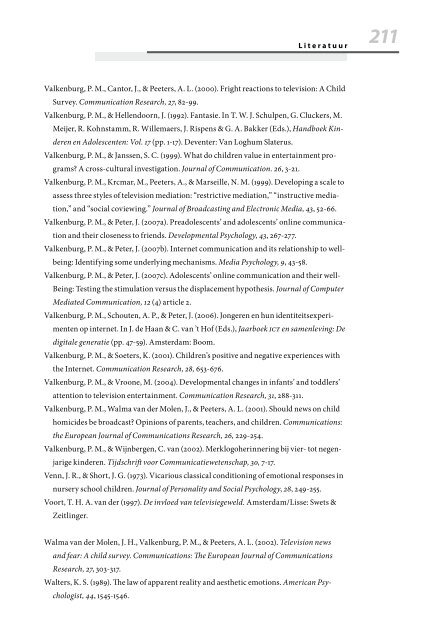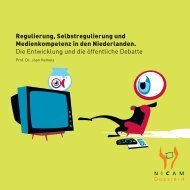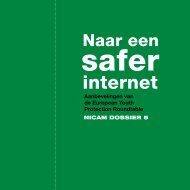Download PDF: Beeldschermkinderen - Kijkwijzer
Download PDF: Beeldschermkinderen - Kijkwijzer
Download PDF: Beeldschermkinderen - Kijkwijzer
You also want an ePaper? Increase the reach of your titles
YUMPU automatically turns print PDFs into web optimized ePapers that Google loves.
Literatuur<br />
Valkenburg, P. M., Cantor, J., & Peeters, A. L. (2000). Fright reactions to television: A Child<br />
Survey. Communication Research, 27, 82-99.<br />
Valkenburg, P. M., & Hellendoorn, J. (1992). Fantasie. In T. W. J. Schulpen, G. Cluckers, M.<br />
Meijer, R. Kohnstamm, R. Willemaers, J. Rispens & G. A. Bakker (Eds.), Handboek Kin-<br />
deren en Adolescenten: Vol. 17 (pp. 1-17). Deventer: Van Loghum Slaterus.<br />
Valkenburg, P. M., & Janssen, S. C. (1999). What do children value in entertainment pro-<br />
grams? A cross-cultural investigation. Journal of Communication. 26, 3-21.<br />
Valkenburg, P. M., Krcmar, M., Peeters, A., & Marseille, N. M. (1999). Developing a scale to<br />
assess three styles of television mediation: “restrictive mediation,” “instructive media-<br />
tion,” and “social coviewing.” Journal of Broadcasting and Electronic Media, 43, 52-66.<br />
Valkenburg, P. M., & Peter, J. (2007a). Preadolescents’ and adolescents’ online communica-<br />
tion and their closeness to friends. Developmental Psychology, 43, 267-277.<br />
Valkenburg, P. M., & Peter, J. (2007b). Internet communication and its relationship to well-<br />
being: Identifying some underlying mechanisms. Media Psychology, 9, 43-58.<br />
Valkenburg, P. M., & Peter, J. (2007c). Adolescents’ online communication and their well-<br />
Being: Testing the stimulation versus the displacement hypothesis. Journal of Computer<br />
Mediated Communication, 12 (4) article 2.<br />
Valkenburg, P. M., Schouten, A. P., & Peter, J. (2006). Jongeren en hun identiteitsexperi-<br />
menten op internet. In J. de Haan & C. van ’t Hof (Eds.), Jaarboek ICT en samenleving: De<br />
digitale generatie (pp. 47-59). Amsterdam: Boom.<br />
Valkenburg, P. M., & Soeters, K. (2001). Children’s positive and negative experiences with<br />
the Internet. Communication Research, 28, 653-676.<br />
Valkenburg, P. M., & Vroone, M. (2004). Developmental changes in infants’ and toddlers’<br />
attention to television entertainment. Communication Research, 31, 288-311.<br />
Valkenburg, P. M., Walma van der Molen, J., & Peeters, A. L. (2001). Should news on child<br />
homicides be broadcast? Opinions of parents, teachers, and children. Communications:<br />
the European Journal of Communications Research, 26, 229-254.<br />
Valkenburg, P. M., & Wijnbergen, C. van (2002). Merklogoherinnering bij vier- tot negen-<br />
jarige kinderen. Tijdschrift voor Communicatiewetenschap, 30, 7-17.<br />
Venn, J. R., & Short, J. G. (1973). Vicarious classical conditioning of emotional responses in<br />
nursery school children. Journal of Personality and Social Psychology, 28, 249-255.<br />
Voort, T. H. A. van der (1997). De invloed van televisiegeweld. Amsterdam/Lisse: Swets &<br />
Zeitlinger.<br />
Walma van der Molen, J. H., Valkenburg, P. M., & Peeters, A. L. (2002). Television news<br />
and fear: A child survey. Communications: The European Journal of Communications<br />
Research, 27, 303-317.<br />
Walters, K. S. (1989). The law of apparent reality and aesthetic emotions. American Psy-<br />
chologist, 44, 1545-1546.<br />
211







